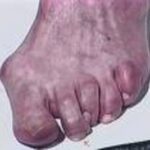Why do we get ingrown toenails? How do we combat this pesky and painful malady? Certain factors make you more inclined to getting ingrown toenails, although they can happen to anybody.
Causes of ingrown toenails
You’re cutting your toenails wrong. Cut straight across rather than to the natural curve of your toe. If you don’t like this look, file it the way you want it after trimming straight across.
You’re rough on your feet. Bumping your feet and injuring them in sports or work can lead to abnormal growth, toenail thickening and ingrown toenails. Even light bumps can lead to this, depending on your own body’s reaction.
You wear shoes that are wrong for you. Tight shoes push the skin against the nail; loose shoes can rub in the wrong places.
You have thickened toenails. It might be from a fungal infection or an underlying medical problem, but thicker toenails mean more ingrown toenails and infections. Fight the cause of the thickened nails and you’ll fight the cause of a reoccurring ingrown toenail.
Your nail bed is growing incorrectly. In this case, you have frequent problems with ingrown toenails. A doctor may have to remove the toenail.
Enough about causes, what about solutions?
There is no immediate remedy to ingrown toenails. You can only alleviate the pain and infection while waiting for it to heal.
Take some acetaminophen or ibuprofen to help with the pain.
Soak your feet with a bit of Epsom salts, but keep them dry when they aren’t soaking. You can soak your feet anywhere from 2-4 times in a day, for no longer than 10-25 minutes at a time. Keep your feet dry and clean when they aren’t in the bath.
Use tweezers tenderly to pull the nail out of the skin, but don’t pull the nail out completely (like a splinter) or cut it down to a nub. When you do this, you’ll have to do it gently, after the feet have been soaked for a few minutes in a foot bath. If you have to dig around to pull out the nail or you pull it off of your toe completely, there’s a higher chance of recurrence.
Wear sandals. Better yet, go barefoot, provided you’re in your own home. Basically, the more air the toe gets, the better, as long as it’s kept clean and dry.
Don’t use nail polish while healing. Toe nails need to breathe.
Floss your feet. Sometimes the area is swollen enough that the ingrown toenail is rubbing up against the infected area and has a chance to re-embed. To combat this, you’ll want to take plain dental floss, not the flavored kind, and put it between the skin and the toenail to separate it. To keep that in place it helps to use a light band aid with a topical antibiotic treatment such as Neosporin. This is a good treatment to observe if you must wear shoes and can’t expose your toes to air.
Night treatment. Most of the time, ingrown toenails will correct themselves after being pulled out of the skin and allowed to continue to grow until they are long enough to trim or file. However, if you’ve waited too long before using a home treatment, you might have enough of an infection that you’ll want to apply antibacterial cream at night.
Tea tree oil. If you’re underlying problem is thickened nails due to nail fungus, you might want to treat your toenails with tree oil soaked cotton balls to apply to your feet at night. (secure with a band aid). Do use about a 1% solution, as tea tree oil is very strong.
Go to the doctor.
You will need to go to the doctor if:
You’re diabetic or have any condition wherein the extremities lack an adequate blood flow. Some diabetic patients will actually go to the doctor’s for a nail trim rather than trusting themselves to do it, because diabetics often lose some of the feeling in their lower extremities and will cut incorrectly or too short.
When a diabetic does get a foot infection, whether it is an ingrown toenail or simply a wound of some sort, it can take their body longer to heal it, which leads to a higher chance of infection. The slow healing coupled with a lack adequate of circulation and the inability to feel much pain makes foot infections potentially dangerous.
The infection is persistent, very ugly looking or it keeps coming back. If the infection doesn’t clear up or start to get better with in 2-3 days, or if you see red striped lines, it’s time to see a doctor. You can actually get blood poisoning from an ingrown toenail. It’s rare, but it does happen.
What the doctor will do
The doctor will prescribe topical and/or oral antibiotics. He may also perform minor surgery on your toe by removing the ingrown part of your toenail. Depending on how much is removed of the nail, this procedure can either eliminate the pain fairly quickly (in a few days) or it could take months to recover. If your doctor is removing a large part of the nail, it will take some time for it to grow back. When it does you should have no further problem as long as you maintain your toes, cutting them properly and watching for fungal infection.
Sometimes, if the problem reoccurs on a regular basis, a doctor may remove the entire toenail. When the toenail grows back, it generally grows back in such a way that ingrown toenails no longer occur.



